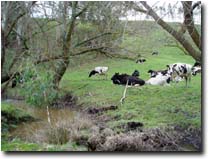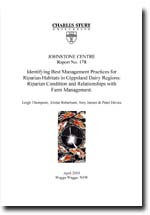Module 5: Riparian condition and land-use practices: A survey of riparian health on dairy farms
Productive Grazing, Healthy Rivers - Home
| Background Intensive grazing reduces environmental quality through the degradation of riparian land, loss of vegetation and biodiversity, and reduced water quality. A variety of rapid-appraisal methods have been developed in Australia to assess riparian condition over a variety of spatial scales. In all cases, several variables are measured in a rapid (1-2 hour) survey of sites (100 m-1 km stream reaches) with the intention of providing indicator measures of riparian ecosystem function. |  |
| Aim This research uses previously tested physical variables as indicators of riparian and in-stream condition. The indicators of condition provide information on the ability of the riparian habitat to minimise the impact of high flow events on soil erosion, provide habitat for native biodiversity (in-stream and riparian) and sustain in-stream health. | |
Our approach A rapid appraisal system developed at Charles Sturt University was used to asses 107 riparian sites of different conditions, ranging from relatively pristine (remnant) to highly degraded streams, across Gippsland. The physical measurements have been compared with farm management variables collected for each site such as stocking rate, stock management, fertiliser application in relation to stream and use of riparian land. | |
Current condition of riparian sites on dairy farms in Gippsland is generally ‘very poor’, with no difference between sites on the Gippsland Plain or Strzelecki Ranges.
- Riparian sites in paddocks used for grazing of milking herds were generally in ‘very poor’ condition.
- Riparian sites in the best condition were those contained within fenced-off areas of remnant vegetation, without access to stock
- Fenced off and replanted riparian sites generally received a low condition score owing to the short amount time elapsed since replanting. A significant, positive linear relationship was observed between time since rehabilitation work and condition score ie. longer time since fencing / replanting higher condition score.
- Riparian sites that had been replanted / rehabilitated more than 16 years ago attained condition scores within / approaching ‘excellent’.
- Riparian condition index scores for fenced off streams containing remnant vegetation reached a plateau when vegetation was 30 metres wide on each side of the stream.
- Rehabilitation of degraded riparian sites currently subject to direct access by stock is best achieved by fencing the riparian land to exclude stock. Practices such as the provision of off-stream watering points and the resting of riparian paddocks (that are not fenced to exclude stock) are not effective management practices on dairy farms in Gippsland under current stocking rates.
A copy of the final report from Charles Sturt University can be accessed below. The project team wishes to acknowledge Leigh Thompson of Charles Sturt University for her involvement with this module.
 Final Report - Module 5 |
Dr Sharon Aarons Ph: (03) 5624 2222 Email: Sharon.Aarons@dpi.vic.gov.au |
Module 1: What lives along your stream? Quantifying on-farm riparian biodiversity
Productive Grazing, Healthy Rivers - Improving riparian and in-stream biodiversity - Project Report 2006 - Module 1 - Quantifying on-farm riparian biodiversity (PDF 289KB). To view the information PDF requires the use of a PDF reader. This can be installed for free from the Adobe website (external link).
Module 2: Wood to Water: habitat creation within restored and replanted riparian land
Productive Grazing, Healthy Rivers - Improving riparian and in-stream biodiversity - Project Report 2006 - Module 2 Wood to Water: Habitat creation within replanted riparian land (PDF 142KB). To view the information PDF requires the use of a PDF reader. This can be installed for free from the Adobe website (external link).
Module 3: Regeneration in remnant vegetation: overcoming the barriers
Productive Grazing, Healthy Rivers - Improving riparian and in-stream biodiversity - Project Report 2006 - Module 3 - Regeneration in remnant vegetation: Overcoming the barriers (PDF145KB). To view the information PDF requires the use of a PDF reader. This can be installed for free from the Adobe website (external link).
Module 4: Expert weed system: a support tool for on-farm management
Productive Grazing, Healthy Rivers - Improving riparian and in-stream biodiversity - Project Report 2006 - Module 4 - Riparian weed management system: Development of on-farm management tool (PDF 70KB). To view the information PDF requires the use of a PDF reader. This can be installed for free from the Adobe website (external link).
Module 5: Riparian condition and land-use practices: a survey of riparian health on dairy farms
Productive Grazing, Healthy Rivers - Improving riparian and in-stream biodiversity - Project Report 2006 - Module 5 - Riparian condition and land-use practices: A survey of riparian health & condition on dairy farms (PDF 127KB). To view the information PDF requires the use of a PDF reader. This can be installed for free from the Adobe website (external link).
Module 6: Riparian zone management: reducing water quality impacts from dairy cows
Productive Grazing, Healthy Rivers - Improving riparian and in-stream biodiversity - Project Report 2006 - Module 6 - Riparian zone management: Reducing water quality impacts on dairy cows (PDF 304KB). To view the information PDF requires the use of a PDF reader. This can be installed for free from the Adobe website (external link).


